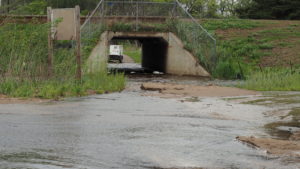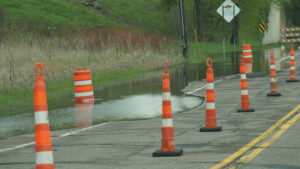
Flood Awareness
Safety Tips & Information Related to Localized Flooding
Ramsey-Washington Metro Watershed District
Throughout our watershed; ponds, wetlands, lakes, creeks & the Mississippi River are expected to rise as rain continues to fall. The National Weather Service estimates that total precipitation amounts will near 1 inch over the next few days. Looking at the extended forecast, atmospheric patterns remain rather active & unsteady. Therefore, the RWMWD is reminding residents of safety tips when dealing with localized flooding and some background information on rainfall and water management.
Extreme Precipitation:
- According to the Minnesota State Climatology Office, 2013-2018 has been the wettest six year period on record.
- Over these six years, we have received an extra 30 inches of precipitation.
- This wet trend has continued throughout 2019. The MSP Airport weather station has reported the wettest water year on record (October 1st 2018 to September 30th, 2019).

Watershed Effects:
The start of 2019 has presented a challenge to water management organizations across the state. Continued above-average precipitation coupled with a substantial winter snowpack has led to elevated and sustained water levels throughout the RWMWD, and elsewhere in the state of Minnesota. We are trying to balance needs across our entire 65 square mile watershed and have been working diligently with our city partners to reduce the risk of flooding to structures. So far, we have been fortunate in that no homes have been flooded by surface waters.
RWMWD Actions:
- Maintaining and monitoring emergency overflows to protect habitable structures from surface flooding.
- Providing surveys and technical resources to local communities in order to efficiently prepare for implementing emergency response plans (protecting habitable structures).
- Monitoring of water level elevations throughout our watershed.
- Continuing to research and invest in long term solutions to build more resiliency into our drainage systems.
Flood Safety Tips:
- Do not swim in flooded waters.
- Do not walk through moving water – 6 inches is enough to knock a person over.
- Do not drive into flooded areas – 12 inches is enough to sweep a vehicle away.
- Remember “turn around, don’t drown!”

Flooding of a Home or Dwelling:
- First and foremost, make sure everyone is safe.
- If an urgent safety situation exists, please call 911.
- Then contact your local city public works office to report the flooding.
Flood Insurance:
- Review your insurance coverage (30-day delay before a flood insurance policy takes effect.)
- Become educated about flood insurance.
- Find out if your policy covers sanitary sewer back-ups.
- Learn more about what you can do now to prevent future damage.
Staying Up-to-Date
We will continue to update our residents using our website, emails and social media platforms.